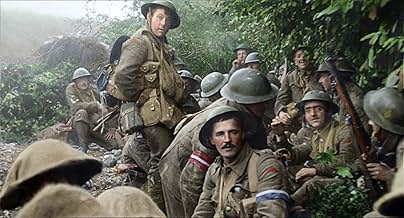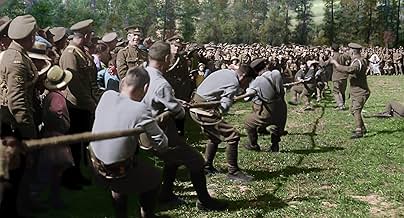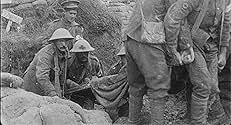NOTE IMDb
8,2/10
40 k
MA NOTE
Un documentaire sur la Première Guerre mondiale avec des images inédites commémorant le centenaire de la fin de la guerre.Un documentaire sur la Première Guerre mondiale avec des images inédites commémorant le centenaire de la fin de la guerre.Un documentaire sur la Première Guerre mondiale avec des images inédites commémorant le centenaire de la fin de la guerre.
- Nomination aux 1 BAFTA Award
- 6 victoires et 14 nominations au total
Thomas Adlam
- Self - Bedfordshire Regiment
- (voix)
- (as Capt Thomas Adlam VC)
William Argent
- Self - Royal Naval Air Service
- (voix)
- (as LM William Argent)
John Ashby
- Self - The Duke of Cambridge's Own (Middlesex Regiment)
- (voix)
- (as Cpl John Ashby)
Attwood
- Self - British Army
- (voix)
- (as Cpl Attwood)
Walter Aust
- Self - East Yorkshire Regiment
- (voix)
- (as Pte Walter Aust)
Donald Bain
- Self - Seaforth Highlanders
- (voix)
- (as Pte Donald Bain)
Thomas Baker
- Self - Chatham Battalion, Royal Naval Division
- (voix)
- (as Pte Thomas Baker)
George Banton
- Self - 50th Division Headquarters
- (voix)
- (as Sig George Banton)
Walter Becklake
- Self - Northhampyonshire Yeomanry
- (voix)
- (as L Cpl Walter Becklake MM)
Arthur Beeton
- Self - Royal Navy Air Service
- (voix)
- (as POM Arthur Beeton)
Robert Bell
- Self - British Army
- (voix)
- (as Mr Robert Bell)
William Benham
- Self - Hawke Battalion, Royal Navy Division
- (voix)
- (as Sub Lt William Benham)
Joseph Biglin
- Self - Durham Light Infantry
- (voix)
- (as Pte Joseph Biglin)
Edwin Bigwood
- Self - Worcestershire Regiment
- (voix)
- (as Pte Edwin Bigwood)
Horace Birks
- Self - Tanks Corps
- (voix)
- (as Capt Horace Birks)
Edmund Blunden
- Self - Royal Sussex Regiment
- (voix)
- (as Lt Edmund Blunden MC)
Clarence Bourne
- Self - Army Service Corps
- (voix)
- (as S Sgt Clarence Bourne)
Allan Bray
- Self - The Duke of Edinburgh's ((Whiltshire Regiment))
- (voix)
- (as L Cpl Allan Bray)
Avis à la une
Utterly haunting movie of life on the western front in WW1. Peter Jackson has thrown some serious computer firepower to bring these soldiers back to life.You will have never seen anything quite like this before.Breathtaking in many parts!
Jackson's remarkable looking documentary is an amalgam of archive footage (much of it originally staged for the 1916 film 'The Battle of the Somme'), with only a tiny amount of actual battle footage given the early nature of film cameras in those days, plus the more moving sight of several of the soldiers staring and smiling into camera, and thanks to skillful lip-reading, speaking through interpreted voices.
The slowing down to our standard 24fps and adding of voices is beautifully touching. I personally don't know if it was essential to colourise as some of the greys in the originals are still visible, when uncolourised black and white footage is still just as immediate (the irony is that so many war films nowadays are drained of colour anyway.) Nonetheless, it is a vivid impression of life on the Western Front that Jackson helps to create, and remains refreshingly objective to its time, reflecting the general pro-war feelings at the beginning in 1914, and through carefully selected testimonies of the many hundreds of soldiers, unfolds the story of a kind of war that had never been seen before, or hopefully never will be again. Sadly humanity never learns its lesson, as the "war to end all wars" is now better known as World War I - all the more reason for history to remind us.
You watch this film, and in some of its more harrowing scenes you can see all the visual influence that Jackson drew upon for his Lord of the Rings trilogy. He dedicated this film to his grandfather who served in the war, and watching it , on the day after my own great grandfather's birthday (who also served in WWI), it was a thought provoking moment that stayed with me for a few hours after.
The slowing down to our standard 24fps and adding of voices is beautifully touching. I personally don't know if it was essential to colourise as some of the greys in the originals are still visible, when uncolourised black and white footage is still just as immediate (the irony is that so many war films nowadays are drained of colour anyway.) Nonetheless, it is a vivid impression of life on the Western Front that Jackson helps to create, and remains refreshingly objective to its time, reflecting the general pro-war feelings at the beginning in 1914, and through carefully selected testimonies of the many hundreds of soldiers, unfolds the story of a kind of war that had never been seen before, or hopefully never will be again. Sadly humanity never learns its lesson, as the "war to end all wars" is now better known as World War I - all the more reason for history to remind us.
You watch this film, and in some of its more harrowing scenes you can see all the visual influence that Jackson drew upon for his Lord of the Rings trilogy. He dedicated this film to his grandfather who served in the war, and watching it , on the day after my own great grandfather's birthday (who also served in WWI), it was a thought provoking moment that stayed with me for a few hours after.
It's only October and I have already seen two Oscar winning films. This (for best documentary) and A star is Born for loads of things.
Months ago I bought a ticket for this special live (3D) screening of this BFI film from the London Film Festival featuring a post film interview between Peter Jackson (the most modest man in cinema) and Mark Kermode (the most adulatory)
I thought it would be special.
It was more than that.
It was a landmark.
It was actually a significant night in cinematic history, because what Peter Jackson has achieved here is unparalleled.
We've all seen colourised war footage. It's interesting, but in reality it's a bit pants.
This is the real deal. A step forward in technology driven by heart, emotion, passion, DNA.
In this truly remarkable documentary Jackson brings us footage from the WW1 front line trenches in a way that you can't even begin to imagine.
First he restored hours of black and white footage to remove grain, scratches, burn marks etc.
Then he graded it.
Then he fixed all the film sprockets so they don't jiggle about and blur.
Then, get this, he turned it all from a hotch-potch of 10/11/12/14/16 and 17 Frames per second into it all being 24 FPS.
This is not insignificant.
A 17 FPS film transferred to 24 frames needs to 'find' 7 frames. It needs to create them, to fill in the gaps to make film flow as we expect. How one does that I have no clue. Frankly, neither does Jackson, but he knows people who were up to it and deliver on the challenge.
So, as Jackson puts it, we don't see Charlie Chaplinesque war footage. We see dignified film of soldiers in real time as our eye would compute it. This is important because it makes it so real.
Then he, frame by frame, colourised the whole lot.
Then he put a team of lip readers onto it to work out what the soldiers were saying when they spoke to camera (in 1914-18 there was no film/sound recording).
Then he recorded both battleground sound effects, by enlisting the NZ army, and the words these soldiers were saying, through actors, and lip synched and background-noised the whole thing.
Then he launched it.
The man is a genius.
The result is beyond words incredible.
On many occasions I gasped out loud, not least when he moved from the first reel, which shows unmodified footage of the preparation of enlistees for WWI, into the reality of war.
In a stunning coup de theatre the screen changes shape.
The audiences audibly gasps.
We are in a new reality.
Now, this all makes it sound like this is simply an exercise in technological show-offery.
No. this focuses on soldiers. Poor. Young. Men.
With terrible teeth, but with opinion, with humour, with dignity, with resolute spirit.
And not just young British men.
Perhaps the most affecting part of this film is where German POW's muck in and join the Brits. It's clear that in those days this was duty and honour for one's country, absolutely NOT hatred of the enemy.
This is a truly remarkable film experience.
It's important.
Find a way of seeing it.
It's much more than a cinematic landmark.
It's a historical one, because the legacy Peter Jackson's 14-18-Now and Imperial War Museum commission gives the world is new technology that will allow all sorts of ancient film archives to become living history.
In this case the 100 minutes that are committed to film are actually backed up by a further 100 hours of monochrome footage that Jackson's team has restored (free of charge) for his commissioners.
See when international honours are handed out (I think Bono has a knighthood for example) Peter Jackson needs to be number one on the list for this real and important achievement.
I assume a further Oscar is in the bag.
Months ago I bought a ticket for this special live (3D) screening of this BFI film from the London Film Festival featuring a post film interview between Peter Jackson (the most modest man in cinema) and Mark Kermode (the most adulatory)
I thought it would be special.
It was more than that.
It was a landmark.
It was actually a significant night in cinematic history, because what Peter Jackson has achieved here is unparalleled.
We've all seen colourised war footage. It's interesting, but in reality it's a bit pants.
This is the real deal. A step forward in technology driven by heart, emotion, passion, DNA.
In this truly remarkable documentary Jackson brings us footage from the WW1 front line trenches in a way that you can't even begin to imagine.
First he restored hours of black and white footage to remove grain, scratches, burn marks etc.
Then he graded it.
Then he fixed all the film sprockets so they don't jiggle about and blur.
Then, get this, he turned it all from a hotch-potch of 10/11/12/14/16 and 17 Frames per second into it all being 24 FPS.
This is not insignificant.
A 17 FPS film transferred to 24 frames needs to 'find' 7 frames. It needs to create them, to fill in the gaps to make film flow as we expect. How one does that I have no clue. Frankly, neither does Jackson, but he knows people who were up to it and deliver on the challenge.
So, as Jackson puts it, we don't see Charlie Chaplinesque war footage. We see dignified film of soldiers in real time as our eye would compute it. This is important because it makes it so real.
Then he, frame by frame, colourised the whole lot.
Then he put a team of lip readers onto it to work out what the soldiers were saying when they spoke to camera (in 1914-18 there was no film/sound recording).
Then he recorded both battleground sound effects, by enlisting the NZ army, and the words these soldiers were saying, through actors, and lip synched and background-noised the whole thing.
Then he launched it.
The man is a genius.
The result is beyond words incredible.
On many occasions I gasped out loud, not least when he moved from the first reel, which shows unmodified footage of the preparation of enlistees for WWI, into the reality of war.
In a stunning coup de theatre the screen changes shape.
The audiences audibly gasps.
We are in a new reality.
Now, this all makes it sound like this is simply an exercise in technological show-offery.
No. this focuses on soldiers. Poor. Young. Men.
With terrible teeth, but with opinion, with humour, with dignity, with resolute spirit.
And not just young British men.
Perhaps the most affecting part of this film is where German POW's muck in and join the Brits. It's clear that in those days this was duty and honour for one's country, absolutely NOT hatred of the enemy.
This is a truly remarkable film experience.
It's important.
Find a way of seeing it.
It's much more than a cinematic landmark.
It's a historical one, because the legacy Peter Jackson's 14-18-Now and Imperial War Museum commission gives the world is new technology that will allow all sorts of ancient film archives to become living history.
In this case the 100 minutes that are committed to film are actually backed up by a further 100 hours of monochrome footage that Jackson's team has restored (free of charge) for his commissioners.
See when international honours are handed out (I think Bono has a knighthood for example) Peter Jackson needs to be number one on the list for this real and important achievement.
I assume a further Oscar is in the bag.
100 years on from the Great War we cannot pretend to know what life was like serving in the trenches. This incredible film brings us as close to experiencing it as we are ever going to get.
It is harrowing, it is poignant, it is funny. Above all else this film is heartbreaking. No punch is pulled, no attempt is made to hide the brutality of war or the hardship of the common soldier.
Quite simply this amazing documentary should be made compulsory viewing in all schools and for every soapbox, warmongering politician that would send our youth into hell.
It is harrowing, it is poignant, it is funny. Above all else this film is heartbreaking. No punch is pulled, no attempt is made to hide the brutality of war or the hardship of the common soldier.
Quite simply this amazing documentary should be made compulsory viewing in all schools and for every soapbox, warmongering politician that would send our youth into hell.
Everyone over the age of 13 should be made to watch this.
This is simple exceptional work at every level from Peter Jackson and his team.
It showed the pure fragility of life, and how the soldiers dealt with it, mainly with humour and machine gun boiled tea.
It's haunting yet funny, disturbing yet uplifting. It's war. And this is the closest I ever want to come to it.
This is simple exceptional work at every level from Peter Jackson and his team.
It showed the pure fragility of life, and how the soldiers dealt with it, mainly with humour and machine gun boiled tea.
It's haunting yet funny, disturbing yet uplifting. It's war. And this is the closest I ever want to come to it.
Le saviez-vous
- AnecdotesMuch of the footage had never been seen, having sat in the vaults of London's Imperial War Museum for many years.
- GaffesSeveral shots of tanks appear in the film, both Mark V (Mark Five) and Mark V* (Mark Five Star). They have been colourised green. In reality, tanks of these types were painted "a neutral brown colour". See the article by the British Tank Museum which states that. "Surrendering to the inevitable, towards the end of 1916 it was ordered that the tanks should be painted in a 'neutral brown colour' all over." These tanks entered service in 1918, and were factory-painted brown.
- Citations
Soldier: [waving at camera] Hi, mum.
- Crédits fous"Filmed on location on the Western Front, 1914 to 1918"
- ConnexionsFeatured in Front Row: Épisode #3.3 (2018)
Meilleurs choix
Connectez-vous pour évaluer et suivre la liste de favoris afin de recevoir des recommandations personnalisées
- How long is They Shall Not Grow Old?Alimenté par Alexa
Détails
- Date de sortie
- Pays d’origine
- Sites officiels
- Langue
- Aussi connu sous le nom de
- They Shall Not Grow Old
- Lieux de tournage
- Sociétés de production
- Voir plus de crédits d'entreprise sur IMDbPro
Box-office
- Montant brut aux États-Unis et au Canada
- 17 956 913 $US
- Montant brut mondial
- 21 656 913 $US
- Durée1 heure 39 minutes
- Couleur
- Mixage
- Rapport de forme
- 1.33 : 1(original footage)
- 1.85 : 1
Contribuer à cette page
Suggérer une modification ou ajouter du contenu manquant



















